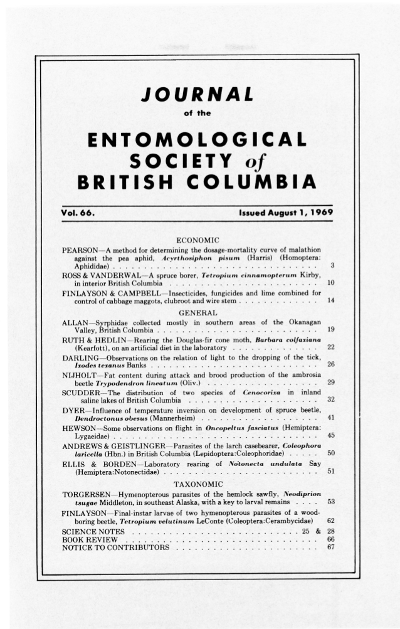A method for determining the dosage-mortality curve of malathion against the pea aphid, <i>Acyrlthosiphom pisum</i> (Harris) (Homoptera: Aphididae)
Keywords:
<i>Acyrlthosiphom pisum</i>, Homoptera, AphididaeAbstract
The procedures of a reliable method for establishing the dosage-mortality curve for malathion and the pea aphid, <i>Acyrthosiphon pisum</i> (Harris), are described and evaluated. They include the choice of insecticide formulation, the conditions for rearing and collecting, the holding of treated aphids, and the analysis of mortality data. The LD50 of actual malathion in acetone solution to the pea aphid is 23.5 nanograms per aphid. The 95% fiducial limits about this estimate are 22.9 and 24.1 nanograms per aphid. The slope, ± S.E. (n=7) of the log-dosage:probit-mortality line is 5.5 ± 0.4.References
Baerecke, M.L. 1962. Resistenz von Myzus persicae (Sulz.) gegen E605 und Metasystox. Z. Pflanzenkrankh. u Pflanzenschutz. 69:453-461.
Bliss, C.I. 1952. The Statistics of Bioassay. New York: Academic Press Inc.
Cole, C.L. and Adkisson, P.L. 1964. Daily rhythm in the susceptibility of an insect to a toxic agent. Science 144:1148-1149.
Dickson, R.C., Laird, E.F. and Johnson, M. McD. 1958. Sexuales and eggs of the spotted alfalfa aphid. Ann. Ent. Soc. Am. 51:346-350.
Dunn, J.A. and Kempton, D.P. 1966. Non-stable resistance to demetonmethyl in a strain of Myzus persicae. Entomol. Exptl. Appl. 9:67-73.
Finney, D.J. 1962. Probit Analysis. 2nd Ed. Cambridge Univ. Press, Cambridge, England. 318 pp.
Fisher, R.W. 1967. Diel periodicity in sensitivity of Tetranychus urticae (Acarina:Tetranychidae) to dicofol. Can. Entomologist 99: 281-284.
Hoskins, W.M. and Craig, R. 1962. Uses of bioassay in entomology. Ann. Rev. Entomol. 7:437-464.
Johnson, B. 1966a. Wing polymorphism in aphids III. The influence of the host plant. Entomol. Exptl. Appl. 9: 213-222.
Johnson, B. 1966b. Wing polymorphism in aphids IV. The effect of temperature and photoperiod. Entomol. Exptl. Appl. 9:301-313.
Johnson, B. (1965). Wing polymorphism in aphids II. Interaction between aphids. Entomol. Exptl. Appl. 8:49-64.
Lamb, K.P. and White, D. 1966. Effect of temperature, starvation and crowding on production of alate young by the cabbage aphid, (Brevicoryne brassicae). Entomol. Exptl. Appl. 9:179-184.
Lees, A.D. 1961. Clonal polymorphism in aphids. p. 68-79, in J . S. Kennedy, (Ed.) Insect Polymorphism. Symposium No. 1, Roy. Entomol. Soc. Lond.
Lees, A.D. 1959. The role of photoperiod and temperature in the determination of parthenogenetic and sexual forms in the aphid Megoura viciae Buckton - I The influence of these factors on apterous virginoparae and their progeny. J. Ins. Physiol. 3:92-117.
Potter, C. 1952. An improved laboratory apparatus for applying direct sprays and surface films, with data on the electrostatic charge on atomized spray fluids. Ann. Appl. Biol. 39:1-28.
Stern, W.M. 1962. Increased resistance to organophosphorus insecticides in the parthenogenetic spotted alfalfa aphid, Therioaphis maculata, in California. J. Econ. Entomol. 55:900-904.
Suomalainen, E. 1962. Significance of parthenogenesis in the evolution of insects. Ann. Rev. Entomol. 7:349-366.
Uichanco, L.B. 1924. Studies on the embryogeny and postnatal development of the Aphididae with special reference to the history of the "symbiotic organ" or "mycetom". Phillippine J Sci. 24:143-247.
White, M.J.D. 1945. Animal Cytology and Evolution. Cambridge Univ. Press, Cambridge, England. 375 pp.
Downloads
Published
Issue
Section
License
Authors who publish with the Journal of the Entomological Society of British Columbia agree to the following terms:
-Authors retain copyright and grant the journal right of first publication with the work simultaneously licensed under a Creative Commons Attribution License that allows others to share the work with an acknowledgement of the work's authorship and initial publication in this journal.
-Authors are able to enter into separate, additional contractual arrangements for the non-exclusive distribution of the journal's published version of the work (e.g., post it to an institutional repository or publish it in a book), with an acknowledgement of its initial publication in this journal.
-Authors are permitted and encouraged to post their work online (e.g., in institutional repositories or on their website) prior to and during the submission process, as it can lead to productive exchanges, as well as earlier and greater citation of published work (See The Effect of Open Access).


